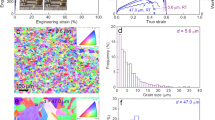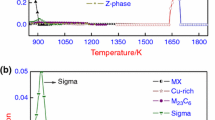Abstract
The austenitic stainless steels are Fe-Cr alloys with sufficient nickel and manganese (and sometimes nitrogen) to stabilize austenite, a face-centered cubic (f.c.c.) phase. Chromium provides corrosion resistance. The most typical austenitic stainless steels are variations of the 18Cr-9Ni alloy. Although none of the commercial alloys were specifically developed for low-temperature service, several of them have been widely used in a variety of cryogenic applications. Their popularity stems from their retention of excellent mechanical properties, particularly toughness, at low temperatures coupled with ready availability, ease of fabrication, and good service experience. Their disadvantages are they are more expensive and have lower yield strength than ferritic Fe-Ni steels and aluminum alloys, and their machinability is poorer than that of aluminum alloys.
Access this chapter
Tax calculation will be finalised at checkout
Purchases are for personal use only
Preview
Unable to display preview. Download preview PDF.
Similar content being viewed by others
References
1. LNG Materials and Fluids, D. B. Mann, ed., National Bureau of Standards, Boulder, Colorado (1978).
2. Handbook on Materials for Superconducting Machinery, MCIC-HB-04, Battelle, Columbus, Ohio (1977).
3. Brickner, K. G. and Defilippi, J. D., Mechanical properties of stainless steels at cryogenic temperatures and at room temperature, in Handbook of Stainless Steels, McGraw-Hill, New York (1977), pp. 20-1-20-39.
4. Materials for Cryogenic Service, Engineering properties of austenitic stainless, International Nickel Limited, London (1974).
5. Low Temperature and Cryogenic Steels, Materials Manual, u.S. Steel Corp., Pittsburgh (1966).
6. Nachtigall, A. J., Strain cycling fatigue behavior of ten structural metals tested in liquid helium, liquid nitrogen, and ambient air, in: Properties of Materials for Liquefied Natural Gas Tankage, ASTM STP 579, American Society for Testing and Materials, Philadelphia (1975), pp. 378-396.
7. Shepic, J. A. and Schwartzberg, F. R., Fatigue testing of stainless steels, in: Materials Studies for Magnetic Fusion Energy Applications at Low Temperatures—I, NBSIR 78-884, National Bureau of Standards, Boulder, Colorado (1978), pp. 15-68.
8. Tobler, R. L. and Reed, R. P., Fatigue crack growth resistance of structural alloys at cryogenic emperatures, in: Advances in Cryogenic Engineering, Vol 24, Plenum Press, New York (1978), pp. 82-90.
9. Ledbetter, H. M., Weston, W. F., and Naiman, E. R., Low temperature elastic properties of four austenitic stainless steels, J. Appl. Phys. 46:3855-3860 (1975).
10. Clark, A. F., Childs, G. E., and Wallace, G. H., Electrical resistivity of some engineering alloys at low temperatures, Cryogenics 10:295-305 (1970).
11. Efferson, K. R. and Leonard, W. J., Magnetic Properties of Some Structural Materials Used in Cryogenic Applications, ORNL-4150, Oak Ridge National Laboratory, Oak Ridge, Tennessee (1976), p. 126.
12. Sanderson, G. P. and Llewellyn, D. T., Mechanical properties of standard austenitic stainless steels in the temperature range -196 to +800C, J. Iron Steel Inst. London 207:1129-1146 (1969).
13. McHenry, H. I. and Reed, R. P., Structural alloys for superconducting magnets in fusion energy systems, Nucl. Eng. Des. 58:219-236 (1980).
14. Randak, V. A., Wessling, W., Bock, H. E., Steimaurer, H. and Faust, L., Stahl Eisen 91:1255 (1971).
15. Read, D. T. and Reed, R. P., Toughness, fatigue crack growth and tensile properties of three nitrogen-strengthened stainless steels at cryogenic temperatures, in: The Metal Science of Stainless Steel, American Society of Metals, Metals Park, Ohio (1979), pp. 92-121.
16. Read, D. T. and Reed, R. P., Fracture and strength properties of selected austenitic stainless steels at cryogenic temperatures, Cryogenics 21:415-417 (198l).
17. Ledbetter, H. M., Anomalous low-temperature elastic behavior of a nitrogen-strengthened chromium-manganese stainless steel, Mater. Sci. Eng. 29:255-260 (1977).
18. Ledbetter, H. M. and Collings, E. W., Low-temperature magnetic and elastic-constant anomalies in three manganese stainless steels, in: Metal Science of Stainless Steels, American Institute of Mining, Metallurgical, and Petroleum Engineers, New York (1979).
19. Watson, J. F. and Christian, J. L., Low temperature properties of cold-rolled AISI types 301, 302, 304 ELC, and 310 stainless steel sheet, in: Low-Temperat~re Properties of HighStrength Aircraft and Missile Materials, ASTM STP 287, American Society for Testing and Materials, Philadelphia (1961), pp. 170-193.
20. Watson, J. F. and Christian, J. L., Mechanical properties of high-strength 301 stainless steel sheet at 70, -320, and -423°F in the base metal and welded joint configuration, in: Low-Temperature Properties of High Strength Aircraft and Missile Materials, ASTM STP 287, American Society for Testing and Materials, Philadelphia, (1961), pp. 136-149.
21. Christian, J. L., Gruner, J. D., and Girton, L. D., The effects of cold rolling on the mechanical properties of type 310 stainless steel at room and cryogenic temperatures, Trans. Am. Soc. Met. 57:199–207 (1964).
22. Schwartzberg, F. R. and Kiefer, T. F., Properties of Cryogenically Worked Metals, NASA contractor report No. NASA-CR-134757, National Aeronautics and Space Administration, Washington, D.C. (1975).
23. Favor, R. J., Gideon, D. N., Grover, H. J., Hayes, J. E., and McClure, G. M., Investigation of Fatigue Behavior of Certain Alloys in the Temperature Range of Room Temperature to -423°F, Report WADD TR 61–132, Battelle, Columbus, Ohio (1961).
24. Gideon, D. N., Favor, R. J., Koppenhafer, A., Grover, H. J., and McClure, M., Investigation of Notched Fatigue Behavior of Certain Alloys in the Temperature Range of Room Temperature to -423°F, ASD-TRD-62–351, Battelle, Columbus, Ohio (1962).
25. Read,D. T., McHenry, H. I., Steinmeyer, P. A., and Thomas, R. D., Jr., Metallurgical factors affecting the toughness of 316L SMA weldments at cryogenic temperatures, Weld. J. 59:104s–113s (1980).
26. Szumachowski, E. R. and Reid, H. F., Cryogenic toughness of SMA austenitic stainless steel weld metals: Part I-Role of ferrite, Weld. J. 57:325s–333s (1978).
27. Elmer, J. W., McHenry, H. I., and Whipple, T. A., Strength and toughness of fully austenitic stainless steel filler metals at 4K, in: Materials Studies for Magnetic Fusion Energy Applications at Low Temperatures—IV, NBSIR 81–1645, National Bureau of Standards, Boulder, Colorado (1981), pp. 289–302.
28. Whipple, T. A. and Kotecki, D. J., Weld process study for 316L stainless steel weld metal for liquid helium service, in: Materials Studies for Magnetic Fusion Energy Applications at Low Temperatures—IV., NBSIR 81–1645, National Bureau of Standards, Boulder, Colorado (1981), pp. 303–321.
29. Lancaster, J. F., The Metallurgy of Welding, Brazing.and Soldering, American Elsevier, New York (1965).
30. Whipple, T. A., McHenry, H. I., and Read, D. T., Fracture behavior of ferrite-free stainless steel welds in liquid helium, Weld. J. 60:72s–78s (1981).
31. Whipple, T. A. and McHenry, H. I., The mechanical properties of stainless steel castings at 4 K, in: Austenitic Stainless Steels at Low Temperatures, Plenum Press, New York (1982).
Author information
Authors and Affiliations
Editor information
Editors and Affiliations
Rights and permissions
Copyright information
© 1983 Plenum Press, New York
About this chapter
Cite this chapter
McHenry, H.I. (1983). The Properties of Austenitic Stainless Steel at Cryogenic Temperatures. In: Reed, R.P., Horiuchi, T. (eds) Austenitic Steels at Low Temperatures. Springer, Boston, MA. https://doi.org/10.1007/978-1-4613-3730-0_1
Download citation
DOI: https://doi.org/10.1007/978-1-4613-3730-0_1
Publisher Name: Springer, Boston, MA
Print ISBN: 978-1-4613-3732-4
Online ISBN: 978-1-4613-3730-0
eBook Packages: Springer Book Archive




